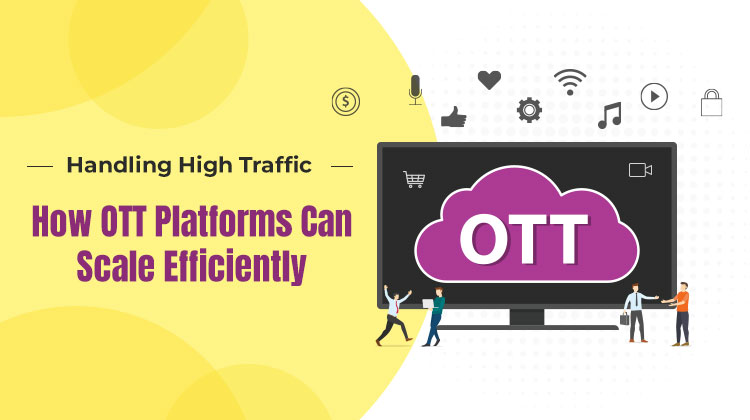
10 Nov, 2024
OTT platforms have changed the entertainment game, offering viewers endless options with just a few clicks. But as these platforms attract larger audiences, keeping up with high traffic has become a vital part of their development. Scalability is now at the heart of any successful OTT platform, allowing it to meet surges in demand and provide a consistent, enjoyable streaming experience. In this blog, we’ll explore the strategies that help OTT platforms scale to handle growing audiences and deliver flawless service every time.
The Growing Demand for OTT Platforms
As consumer habits shift from traditional media to on-demand streaming, the demand for OTT platforms has exploded. From entertainment and news to sports and educational content, users expect smooth, uninterrupted access to their preferred media. However, as the user base of an OTT platform grows, so do the challenges of managing high traffic during peak hours. Events like live sports or the release of a highly anticipated series can result in sudden traffic spikes, which, if not properly managed, can lead to buffering, crashes, and dissatisfied users.
For businesses involved in Custom OTT platform development, scalability is a top priority. Platforms must be built with infrastructure that can handle fluctuating demand without sacrificing performance. Integrating the right technologies and planning for future growth are crucial steps in creating scalable OTT platforms that can accommodate increasing traffic while providing a smooth user experience.
Understanding the Impact of High Traffic on OTT Platforms
To effectively manage high traffic, it's important to understand how an influx of users can impact a platform's performance. Sudden spikes in traffic can lead to slower load times, buffering, and even complete service outages if the platform’s infrastructure isn’t built to scale. These performance issues can negatively affect the user experience, potentially leading to user churn as frustrated viewers look for alternatives.
Managing high traffic requires more than just strong infrastructure; it demands scalable architecture and real-time monitoring. During development, ensuring that the platform can dynamically adjust to sudden spikes in demand is key to avoiding these common issues.
Strategies for Scaling OTT Platforms
Scaling an OTT platform efficiently means implementing solutions that can dynamically handle traffic surges without causing service disruptions. Below are some key strategies used by successful OTT platform development projects:
1. Content Delivery Networks (CDNs)
One of the most effective ways to manage high traffic is by utilizing Content Delivery Networks (CDNs). CDNs are networks of distributed servers that deliver content to users based on their geographical location, reducing latency and ensuring faster delivery—even during peak traffic times.
Incorporating CDNs into the architecture of an OTT platform distributes the traffic load, reducing the risk of server overload. CDNs are especially useful for OTT platforms that serve a global audience, as they help improve viewing experiences for users in different regions. In any OTT app development project, CDNs should be a core component of the strategy to enhance both performance and scalability.
2. Cloud-Based Infrastructure
One of the crucial aspects of OTT platforms development is leveraging cloud infrastructure. Cloud-based platforms offer the flexibility and scalability needed to handle traffic spikes effectively. By utilizing cloud resources, OTT platforms can dynamically scale server capacity based on real-time demand. For instance, during a live event or the release of a new show, the platform can allocate additional resources to manage the surge in users.
Cloud infrastructure eliminates the need for significant upfront investment in hardware and allows the platform to expand as needed. Partnering with an OTT platform development company experienced in cloud solutions ensures that your platform remains adaptable and scalable, meeting user demand efficiently.
3. Microservices Architecture
A microservices architecture divides the OTT platform into smaller, independent services, each responsible for specific functionalities like user authentication, content streaming, and payment processing. This architecture enables better fault isolation and easier scaling, as individual services can be scaled independently based on demand.
By adopting a microservices approach, OTT platforms can manage high traffic more effectively. For instance, if the user authentication service is experiencing a traffic surge, resources can be allocated to that specific service without affecting the content streaming functionality. OTT app development companies that implement microservices architecture create platforms that are not only scalable but also more maintainable and adaptable over time.
4. Adaptive Bitrate Streaming
Adaptive bitrate streaming adjusts the quality of the video stream based on the user's internet speed and device capabilities. This ensures that users with slower internet connections receive lower-quality streams, while users with faster connections can enjoy high-definition content.
Adaptive streaming helps reduce server load during high-traffic periods by dynamically adjusting the bitrate to match each user's conditions. This optimizes resource use while improving the user experience, as buffering and loading issues are minimized. In any project, integrating adaptive bitrate streaming is essential for managing server load during peak times.
Monitoring and Managing Traffic in Real Time
Scaling an OTT platform isn’t just about implementing the right infrastructure—it also involves continuous monitoring and real-time traffic management. Tools that track server loads, user activity, and performance metrics in real-time allow platform operators to respond quickly to traffic spikes and resolve issues before they escalate.
A key component of real-time traffic management is load balancing. Load balancers distribute incoming traffic across multiple servers, ensuring that no single server becomes overwhelmed. This helps maintain smooth performance even during periods of high traffic. Additionally, using AI and machine learning tools in OTT platforms development can enable predictive analytics, allowing platforms to anticipate traffic spikes and prepare accordingly.
The Future of High Traffic Management in OTT Platforms
As OTT platforms continue to gain popularity, managing high traffic will remain a central challenge. Future advancements in AI, machine learning, and edge computing promise to make traffic management even more efficient. AI-driven algorithms can predict user behavior, anticipate traffic spikes, and optimize server loads in real-time, providing a smoother experience for viewers.
For businesses involved in custom OTT platform development, staying ahead of these technological advancements will be crucial to maintaining a competitive edge. By investing in scalable infrastructure and partnering with an OTT app development company that understands the nuances of high traffic management, businesses can ensure their platforms remain robust and efficient as their user base expands.
Conclusion
Scaling to handle high traffic is no easy task, but it’s essential in a world where audiences expect seamless, instant access to their favorite content. For OTT platforms, this means investing in smart, scalable solutions like CDNs, cloud-based infrastructure, and adaptive bitrate streaming. Together, these strategies form the backbone of a smooth, uninterrupted viewing experience, even when demand is at its highest.
Building a resilient platform isn’t just about technology—it’s about future-proofing your service for an expanding audience. As viewership grows, the ability to scale becomes a competitive advantage, ensuring that every new user experiences the same high-quality streaming as the last. With the right tools in place, your OTT platform is ready to rise to the challenge, delivering a flawless experience to viewers everywhere, every time they press play.
--------------------------------------------------------------------------------------
How do OTT platforms handle millions of users simultaneously?
OTT platforms use advanced technologies like CDNs (Content Delivery Networks), cloud hosting, and load balancing to distribute content and manage user traffic.
How does cloud hosting help in scaling OTT platforms?
Cloud hosting allows OTT platforms to scale resources up or down dynamically based on traffic demand, ensuring optimal performance.
How do CDNs help manage high traffic on OTT platforms?
CDNs reduce latency and server load by caching and delivering content from servers closest to the user.
How does cloud infrastructure improve scalability?
Cloud infrastructure provides on-demand resources, enabling OTT platforms to scale up or down as traffic fluctuates.
Why is traffic monitoring important for OTT platforms?
Monitoring helps identify traffic patterns, detect issues, and optimize performance during high traffic.
Will AI play a larger role in OTT scaling?
Yes, AI will continue to improve predictive scaling, traffic management, and personalization, enhancing scalability and performance.
--------------------------------------------------------------------------------------
You May Also Read
Launching an OTT Platform: Essential Features and Challenges to Consider?
OTT Platform Development: 10 Common Mistakes to Avoid in 2025

